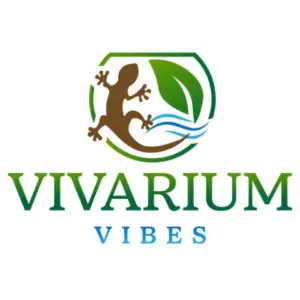This page may contain affiliate links that allow us to make a small commission from qualifying purchases (at no extra cost to yourself). We appreciate your support.
As a Paludarium contains both land and water elements, understanding the best fish suited for the aquarium section of your Paludarium is crucial. As most Paludariums are freshwater based, I decided to do some research and find the best freshwater fish that can thrive and add excitement to your Paludarium.
Below you will find a range of freshwater fish, as well as a couple of surprises, that would all make great pets within your Paludarium. For each of the animals listed, I have included some key information that you will want to think about if considering any of these interesting aquatic species.
Although the majority of freshwater fish prefer water temperatures of between 72-82 degrees, it is important to understand the specific requirements for each fish species. As an added bonus, you will find this information in the below tables for each fish listed.
If your interested in types of semiaquatic or terrestrial animals that can live within your Paludarium, then look no further! I wrote an article covering a large variety of animals that are great for Paludariums which I encourage you to read!
1. Killifish
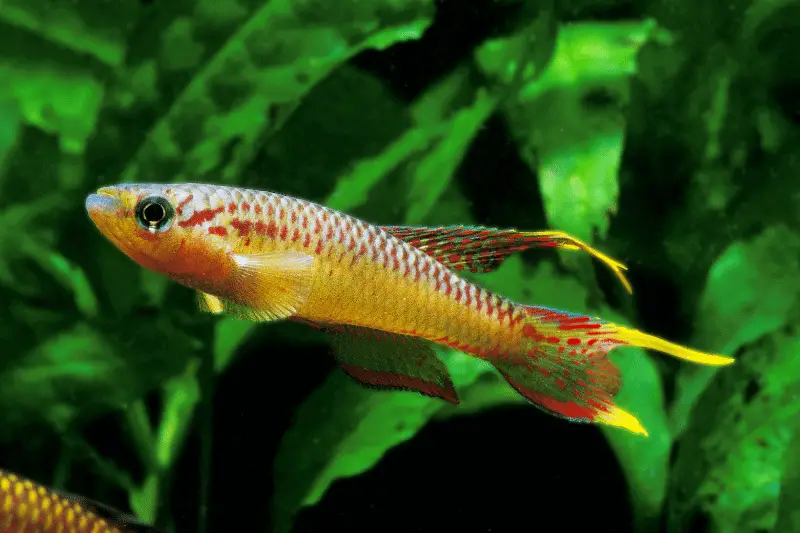
Determining the sex of the Killifish is relatively straightforward. Male killifish have bright colors, like blue, yellow, red, or green, whereas, females show dull colors, such as brown or grey. If you love variety then the Killifish is the right choice for you. There are over 1,000 different species of killifish with the largest species growing up to 6 inches. Most freshwater fish prefer water temperatures between 72-82 degrees but the Killifish generally prefers cooler temperatures of around 68 degrees.
| Name | Killifish |
| Size | 1-3 inches on average |
| Lifespan | 2-5 years |
| Diet | Brine shrimp, insect (mosquito) larvae, aquatic crustaceans and worms. |
| Minimum Tank Size | 5-10 gallons for a pair or trio. 20 gallons + for a community tank or more than one male. |
| Water Temperature (F°) | 72°-75° |
2. Cichlids
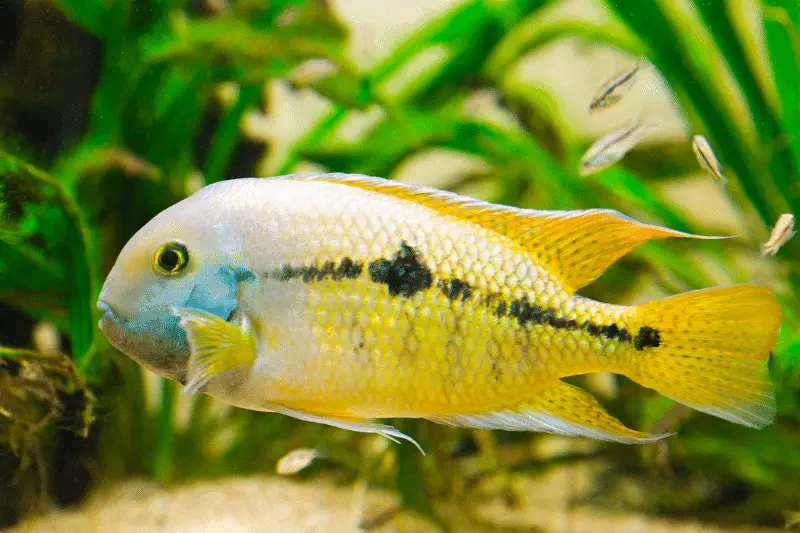
Some species of cichlids are mouth-breeders and instead of placing their eggs in a nest, they will carry them around in their mouth until hatched. One interesting fact about Cichlids is that some species can communicate with each other by changing the color of their bodies.
| Name | Cichlids |
| Size | 4-10 inches on average |
| Lifespan | up to 15 years (depending on species) 7-10 years on average |
| Diet | Flakes, pellets, frozen or live food, green algae |
| Minimum Tank Size | 10 gallons for dwarf species and 30+ gallons for larger species |
| Water Temperature (F°) | 76°-82° |
3. Angelfish
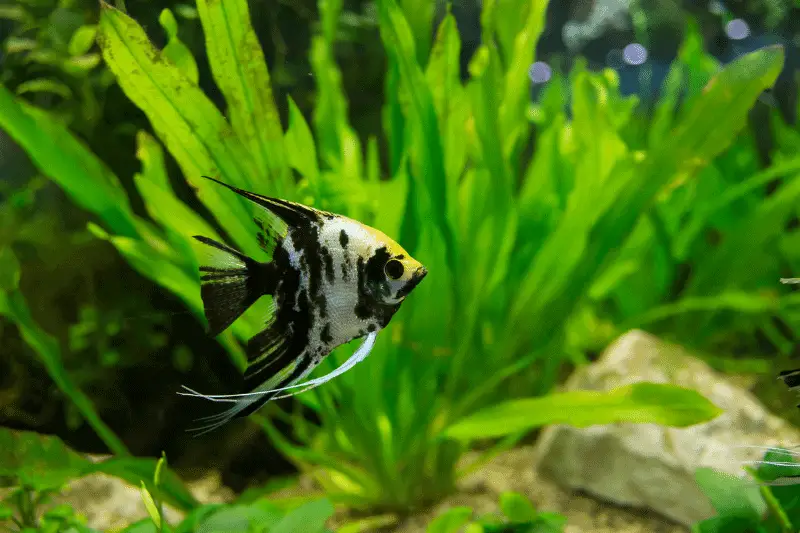
The Angelfish is part of the Cichlid family and is one of the more popular Cichlids used in Paludariums or aquariums. I couldn’t resist having this species as a separate option as I used to love watching these fish in my family aquarium growing up. Angelfish can be great community fish but can become aggressive towards smaller fish and prey on them if hungry enough. Male and females look very similar and can be of a variety of colors. So it may be hard to tell the difference by appearance alone.
| Name | Angelfish |
| Size | 6-8 inches long, up to 10 inches tall (bottom to top fins) |
| Lifespan | 10 years |
| Diet | Flakes, Pellets, Worms, Small Crustaceans, Shrimp, Veggies |
| Minimum Tank Size | 10 gallon for one, 20-30 gallon for 2 or more. |
| Water Temperature (F°) | 78°-84° |
4. Molly Fish
Molly Fish can come in a variety of colors and fin shapes. One interesting thing about these fish is that they give birth live and do not lay eggs. So if your interested in breeding them, the birthing process can be quite fascinating! Baby fish are called “Frys” so a baby molly fish is referred to as a “Molly Fry”.
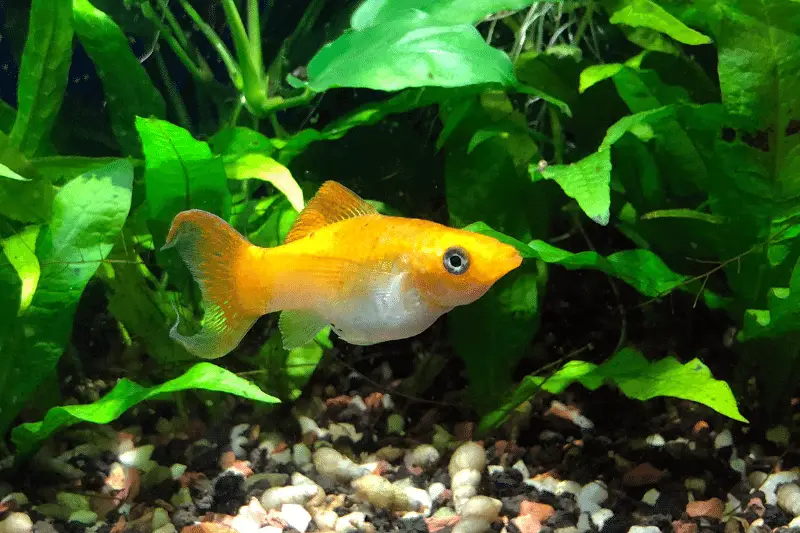
If your looking to have multiple fish species within your Paludarium, then the Molly Fish is a great choice as they are a community fish and get along well with others. They also enjoy eating live plants so be sure to keep plenty of live plants within your Paludarium.
| Name | Molly Fish |
| Size | Adult males 3-4 inches, females 4-10 inches |
| Lifespan | 3-5 years |
| Diet | Small invertebrates, brine shrimp, algae, blanched vegetables (lettuce, spinach, zucchini), plant matter |
| Minimum Tank Size | 10 gallons for up to 4 fish. |
| Water Temperature (F°) | 72°-78° |
5. Danios
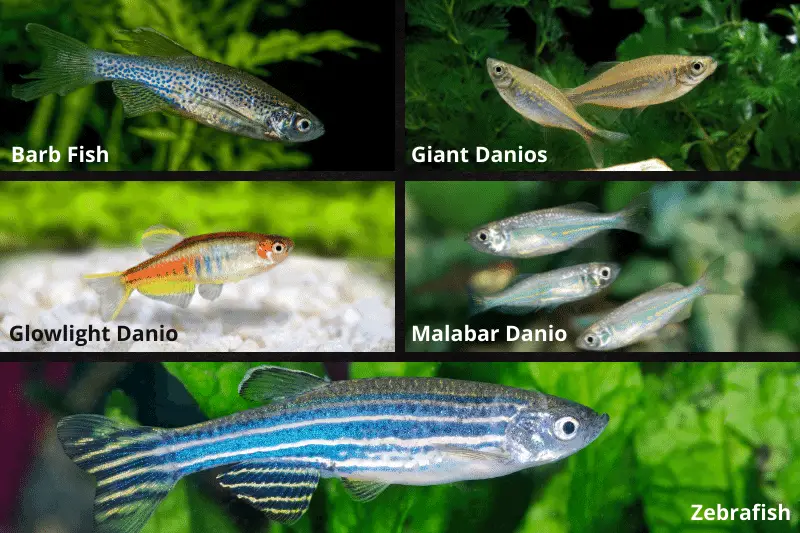
There are a lot of different species of Danios but my top choices for a Paludarium are the Barb Fish, Giant Danios, Glowlight Danio, Malabar Danio, or the Zebrafish. They come in a variety of colors and typically have striped bodies. The minimum tank sizes are 10 gallons for the Dwarf Spotted Danio, Glowlight Danio and the Zebrafish, 20 gallons for the Rosy Danio and Pearl Danio, and 30 gallon for the Giant Danio.
| Name | Danios |
| Size | 2 inches on average, 4 inches for Giant Danio |
| Lifespan | 3-5 years (depending on species) |
| Diet | Flakes, shrimp pellets, zooplankton, insects and insect larvae, small crustaceans, insects, worms and algae |
| Minimum Tank Size | 10-30 gallons (depending on species) |
| Water Temperature (F°) | 70°-78° |
6. Gouramis
There are a lot of different species of Gouramis but my top choices for a Paludarium are the Pearl Gouramis, Dwarf Gouramis, Paradise Fish, Golden Gouramis, or the Opaline Gouramis. When is comes to Gouramis sizes, the Dwarf and Chocolate Gouramis average 2 inches in size and the average size for most other Gouramis is 4-6 inches. The adult kissing Gouramis however, can grow up to 12 inches in the wild but typically will not exceed 6 inches in captivity.
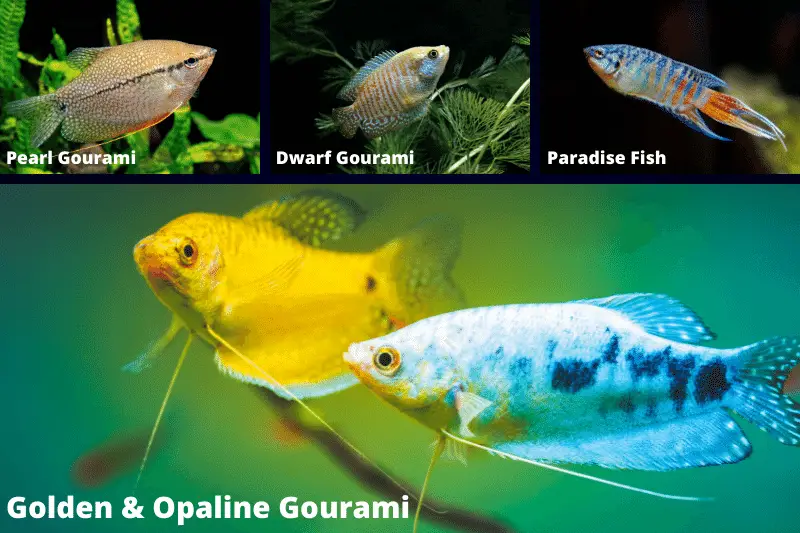
When using frozen and live foods, be aware that they can be used to induce breeding. So be sure to balance out their diet so they aren’t eating the same thing everyday.
| Name | Gouramis |
| Size | 2-6 inches (depending on species) |
| Lifespan | 4-5 years on average |
| Diet | Dry flake food, blanched vegetables (lettuce, spinach, zucchini), blackworms, brine shrimp, and glass worms, crustaceans, aquatic insects and larvae, algae |
| Minimum Tank Size | 5 gallon (Dwarf Gouramis), 20-30 gallon (most other Gouramis species) |
| Water Temperature (F°) | 74°-79° |
7. Guppies
Guppies come in a variety of bright colors and can add a lot of life to your Paludarium. They are extremely easy to care for and get along well with most other fish species. Similar to the Molly Fish, Guppies don’t lay eggs and give birth to live young which can be fascinating to watch.
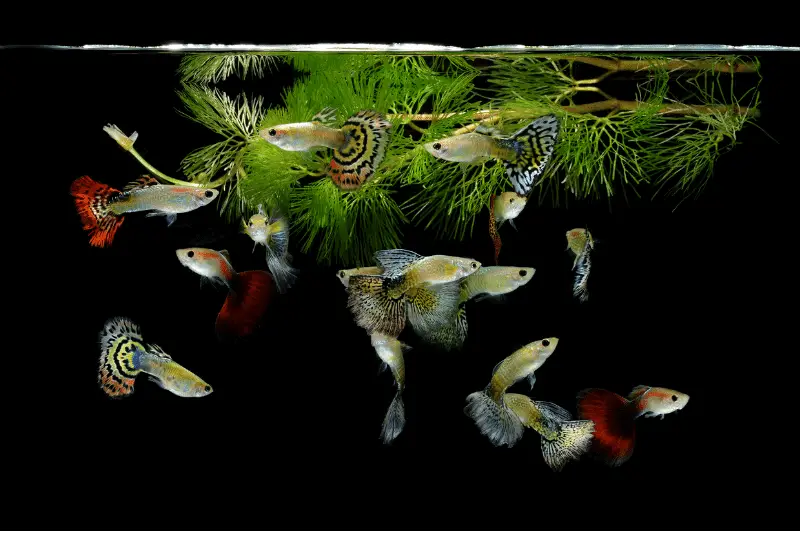
Guppies also tend to eat their young, so if your hoping to keep their babies alive, it is recommended to add some extra plants so that the baby guppies can hide. If your thinking about removing the baby guppies, and keeping them separated for their safety, it is not advised. Removing the young from their parents can cause stress to the adult guppies and lead to premature death.
| Name | Guppies |
| Size | Males (0.6-1.4 inches) Females (1.2-2.5 inches) |
| Lifespan | 1-3 years |
| Diet | Algae, insect larvae, flake food, freeze dried food (brine shrimp, bloodworms or daphnia), vegetables (lettuce, peas, and cucumbers) |
| Minimum Tank Size | 5 gallon (up to 3), 10-20 gallon (3 or more) |
| Water Temperature (F°) | 72°-82° |
8. White Cloud Mountain Minnow
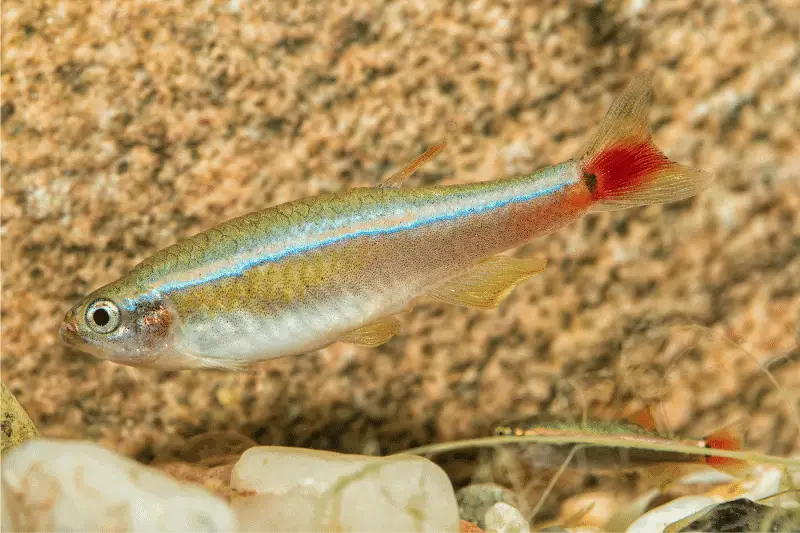
The White Cloud Mountain Minnow is a great community fish but my top choices for tank mates include Ghost Shrimp, Neon Tetras, Fancy Guppies, Glow Light Tetras, Glassfish, or the Paradise Fish. If looking for a specific gender, males tend to be brighter in color than females, with slightly slender bodies. Interestingly, the White Cloud Mountain Minnow was first discovered in 1932 in White Cloud Mountain, near the city of Guangzhou, China, which is where it gets its name.
| Name | White Cloud Mountain Minnow |
| Size | 1.5 inches |
| Lifespan | 5-7 years |
| Diet | Micro worms, brine shrimp, algae, mosquito larvae, daphnia, flake food |
| Minimum Tank Size | 10 gallon |
| Water Temperature (F°) | 64°-72° |
9. Archer Fish
When it comes to Archer Fish, it is important to understand which species you are selecting for your Paludarium as some are not suitable for freshwater. The Toxotes Microlepis and Clouded Archer Fish are freshwater fish but the Branded Archer Fish requires brackish water (a mixture of salt and freshwater). The Branded Archer Fish is usually more common so be sure that your Paludarium can accommodate the specific species of Archer Fish you select.
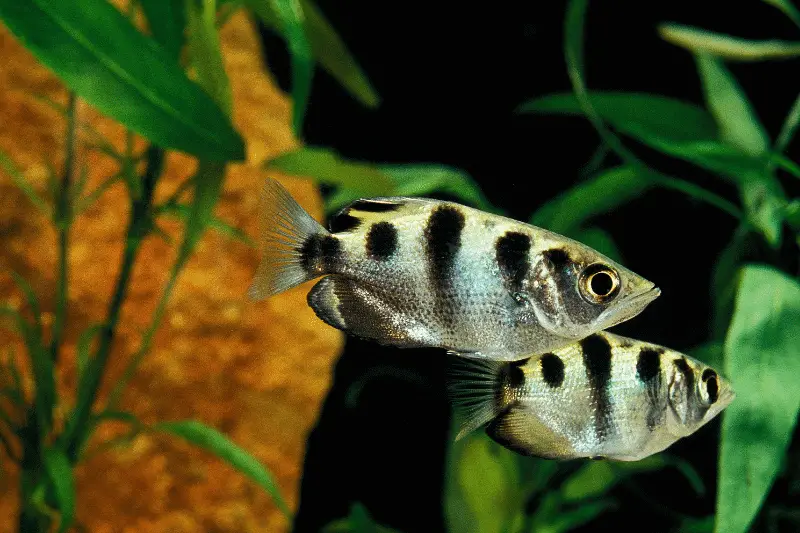
The Archer Fish have a unique shaped mouth that allows them to shoot a stream of water up to five feet like a squirt gun. In the wild, they often use this technique to knock insects off overhanging vegetation for a quick meal. Because of this, Archer Fish will often dwell near the surface of your Paludarium, so be sure to be aware of any other animals in your Paludarium that may decide to go fishing.
| Name | Archer Fish |
| Size | 10-12 inches |
| Lifespan | up to 10 years |
| Diet | Insects, floating vegetable matter (plants, pollen, flower buds and pulpy fruits), small aquatic crustaceans, zooplankton, aquatic insect larvae, and worms |
| Minimum Tank Size | 55-90 gallons |
| Water Temperature (F°) | 68°-82° |
10. Betta Fish
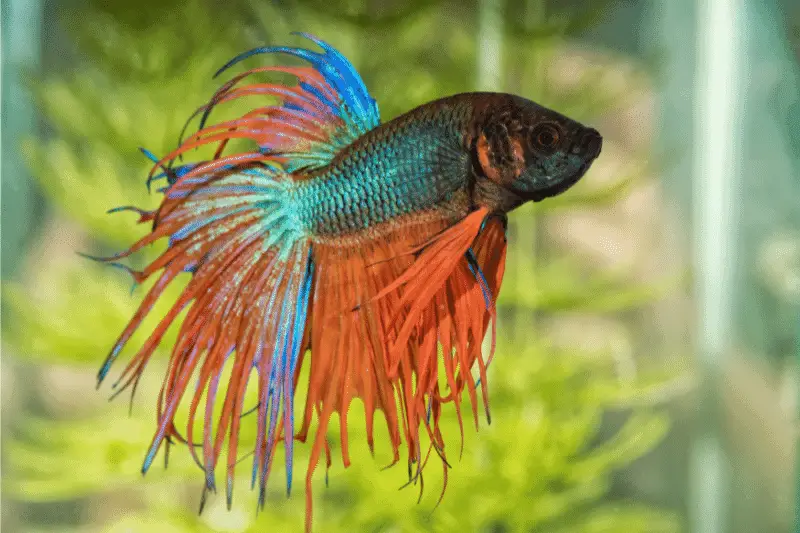
Also known as the Siamese fighting fish, Betta fish come in a large variety of colors which is spread through out their fan-like fins and body. Betta fish like to be alone and can be quite aggressive with other species or male fish. Female Betta Fish may be more suitable for a community tank and can live quite well with Neon tetras, minnows and various species of catfish. Betta Fish are diurnal, so they are awake during the day and asleep during the night, so you shouldn’t have any trouble spotting them throughout the day.
| Name | Betta Fish |
| Size | 2-3 inches |
| Lifespan | up to 3 years |
| Diet | Frozen or freeze dried brine shrimp, bloodworms, or tubifex worms, flakes, pellets |
| Minimum Tank Size | 5 gallon |
| Water Temperature (F°) | 75°-80° |
11. Neon Tetras
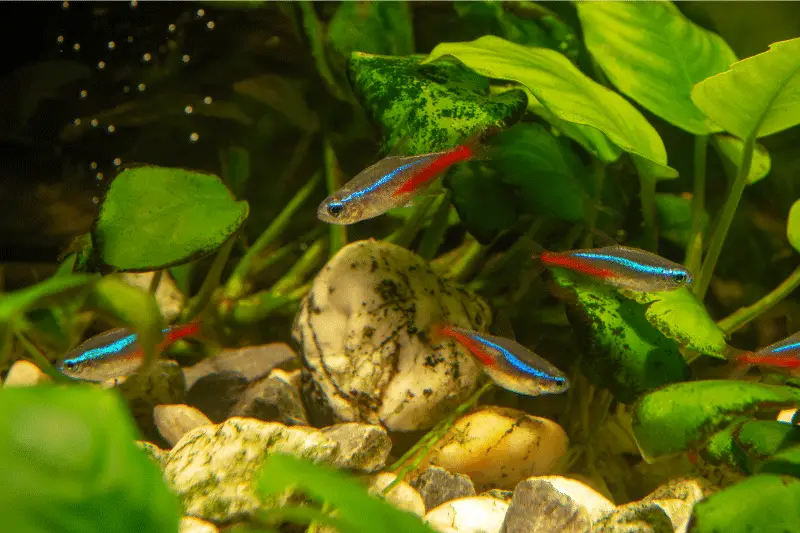
These are one of my favorite additions to any Paludarium or aquarium as I used to have lots of them as pets growing up. They add great color to your tank and are extremely easy to maintain. They are school fish so be sure to keep at least a few of them so they won’t get lonely. They are a popular choice for many people, as over 1.5 million Neon Tetras are imported into the USA each month!
| Name | Neon Tetras |
| Size | up to 2.5 inches |
| Lifespan | 5 years on average. Known to live up to 10 years. |
| Diet | Fine flake food, small granules, algae, small invertebrates, insect larvae, live or frozen brine shrimp or daphnia, and frozen or freeze-dried bloodworms |
| Minimum Tank Size | 10 gallon |
| Water Temperature (F°) | 71°-81° |
12. Pygmy Cory Catfish
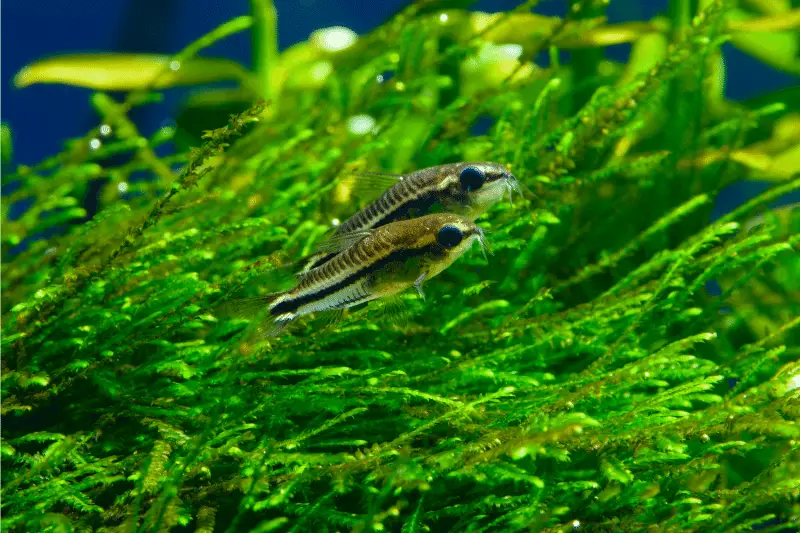
These interesting little Catfish are great for smaller Paludariums and get along fine with other smaller fish due to their peaceful nature. As they have such small mouths, make sure that you break down their food so that it is easily digestible for them. Pygmy Cory Catfish are quite common in community tanks and can easily be found in most pet stores.
| Name | Pygmy Cory Catfish |
| Size | 1 inch on average |
| Lifespan | 3 years |
| Diet | Pellets, wafers, algae, bloodworms, insect larvae, brine shrimp |
| Minimum Tank Size | 10 gallon |
| Water Temperature (F°) | 72°-79° |
13. African Butterfly Fish
The African Butterfly Fish is a great option for Paludariums if your looking for something unique. Their appearance is unlike most fish as they have large pectoral fins that gives the appearance of wings. In the wild, the African Butterfly Fish can actually jump through the air. Not only can this fish break the surface, but they are able to glide for short distances. Obviously being in a Paludarium there isn’t much room to fly but they can still add an exotic presence to your tank environment.
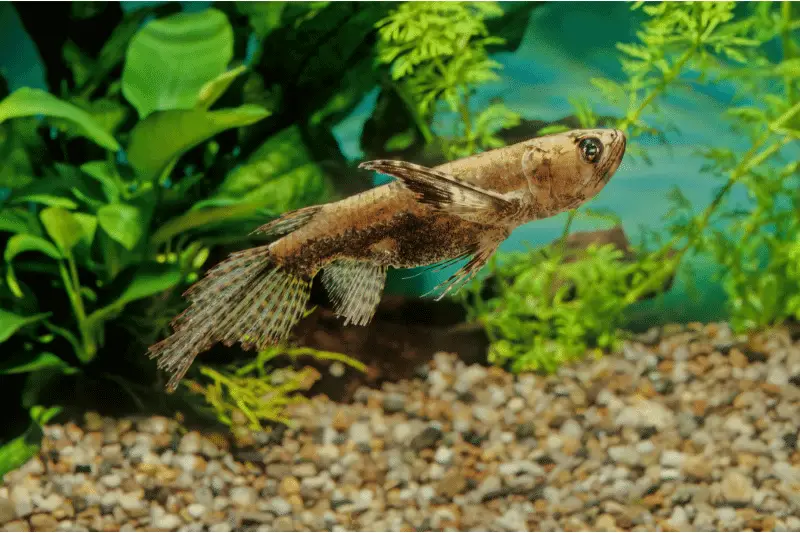
The Paludarium structure is important when considering the minimum 30 gallon tank size for the African Butterfly Fish. These fish will spend most of their time at the surface of the water, so a longer Paludarium tank setup, as opposed to a tall setup, will be more suitable. A tall, deep 30 gallon tank will not provide adequate space for this fish in particular. Be careful of housing with smaller fish as they may see them as prey.
| Name | African Butterfly Fish |
| Size | 5 inches |
| Lifespan | 5-6 years |
| Diet | Live insects, flies, mosquito larvae, small spiders, worms, small fish, brine shrimp, small prawns, and large flake food |
| Minimum Tank Size | 30 gallons |
| Water Temperature (F°) | 77°-82° |
14. Bala Shark
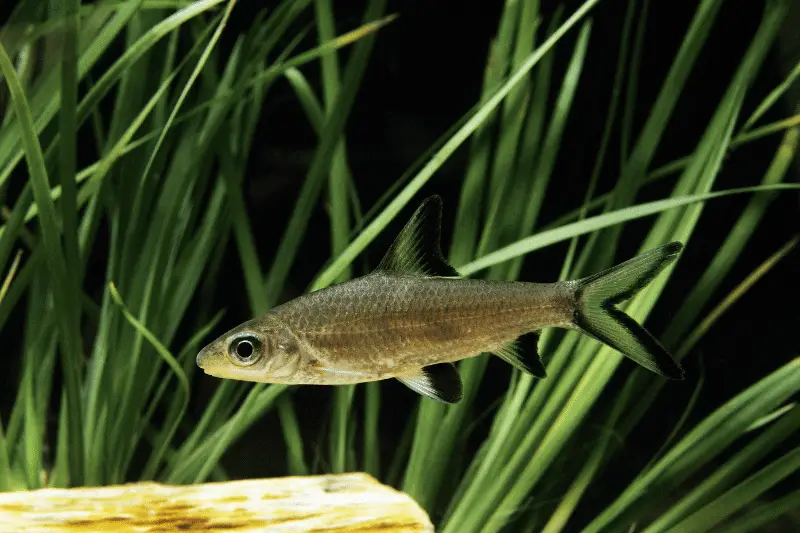
Despite their shark-like appearance, Bala Sharks are actually a relatively peaceful fish. They will however, prey on smaller fish, like the neon tetra, so be sure to take that under consideration when thinking about tank mates. In the wild, invertebrates, such as snails or shrimp, are naturally part of their diet, so it would be best to keep these types of creatures out of your tank to avoid any mishaps. Bala Sharks are schooling fish and can get timid if housed alone. We recommend you house at least four Bala Sharks in your Paludarium, as any less, they tend to fight for dominance and bully each other.
| Name | Bala Shark |
| Size | 13-14 inches |
| Lifespan | 10 years |
| Diet | Dried flakes, granules, algae, small fish, invertebrates (snails, shrimp), Daphnia, bloodworms, brine shrimp, mosquito larvae, tubifex worms, spinach, peas, fresh fruits |
| Minimum Tank Size | 120 gallons |
| Water Temperature (F°) | 72°-82° |
15. Endlers
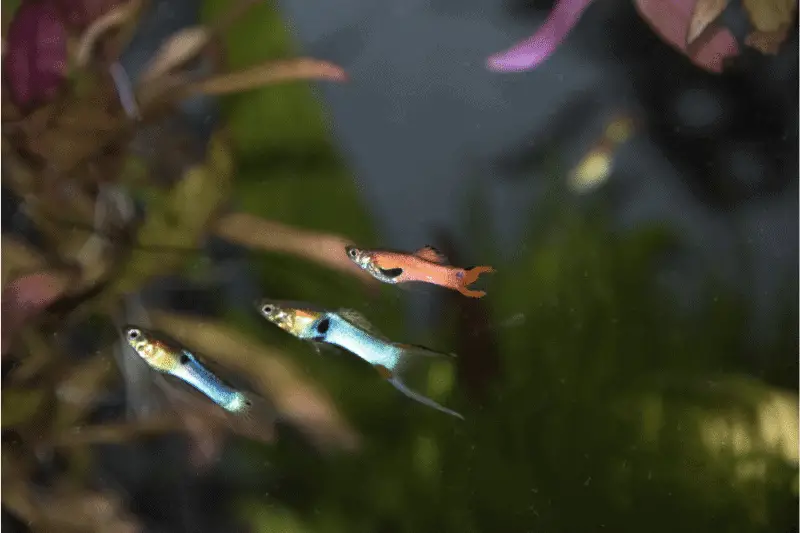
You can easily identify the gender of your Endler as males are a bright, fluorescent color, and females are typically a dull shade of grey or silver. Endlers carry a lot of similarities to guppies and are great community fish that get along well with others. If your looking for some in the wild, you may run into some trouble. They can only be found in a large lake located in Laguna de Patos, Venezuela. Because of this, Endlers are nearing extinction in their natural environment.
| Name | Endlers |
| Size | 1-2 inches |
| Lifespan | 2-3 years |
| Diet | Dry flakes, pellets, bloodworms, daphnia, brine shrimp, black worms, Vegetable matter (spinach, kale, lettuce) |
| Minimum Tank Size | 10 gallon (1-2 Endlers) 20 gallon (3-5 Endlers) |
| Water Temperature (F°) | 72°-82° |
16. Freshwater Shrimp
Although not technically a type of fish, I couldn’t resist adding shrimp to the list as they are such a great addition to any Paludarium. There are many different species of freshwater shrimp that would make great choices for your Paludarium. My favorite choices are the Cherry shrimp, Amano shrimp, Ghost shrimp, Bee shrimp, or Blue dream shrimp. Be sure to house with fish that do not prey on invertebrates.
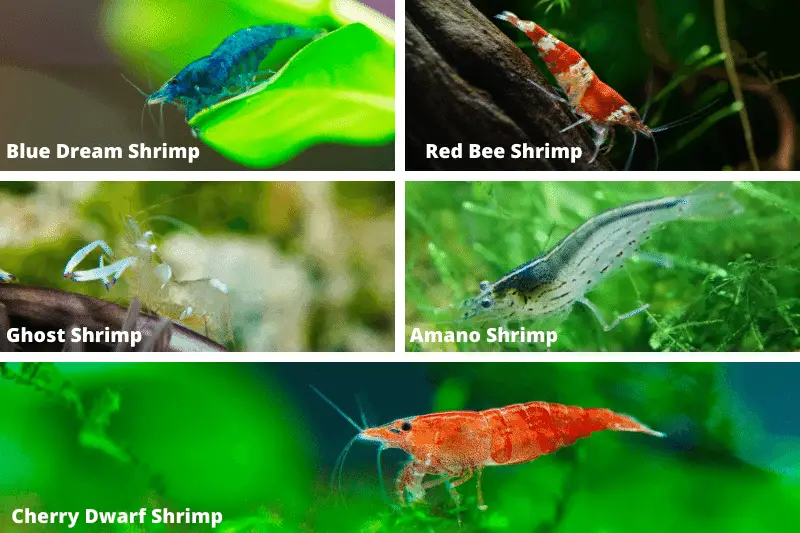
Shrimp are scavengers and will eat just about anything. They are great cleaners and will assist in keeping your Paludarium free from algae build up and other natural deterrents. Don’t be alarmed if it looks like you have dead shrimp lying in your Paludarium. It is most likely a shrimp exoskeleton as they tend to shed about once a week while they are growing. One way you can tell the difference between an exoskeleton and a deceased shrimp is by the color. Deceased shrimp will appear pinkish in color, whereas an exoskeleton will look just like a live shrimp.
| Name | Freshwater Shrimp |
| Size | 1-3 inches (Depending on species) |
| Lifespan | 1-2 years |
| Diet | Algae, bacteria and other microorganisms, decaying plant matter, flakes, shrimp pellets |
| Minimum Tank Size | 5-10 gallons (Depending on Species) |
| Water Temperature (F°) | 66°-77° |
Freshwater Fish That Can Live in a Paludarium Summary
Below is a summary table containing information for a variety of freshwater fish that can live in a Paludarium. No matter your preference, there are plenty of options to help you create the perfect Paludarium. I hope that this article has helped to make that decision easier and has provided useful information for any of the above pet options that you may be considering.

Meet Brad, the creator behind Vivarium Vibes, where his deep connection with nature and animals truly comes to life.
